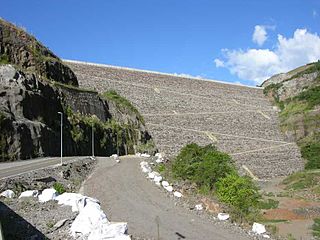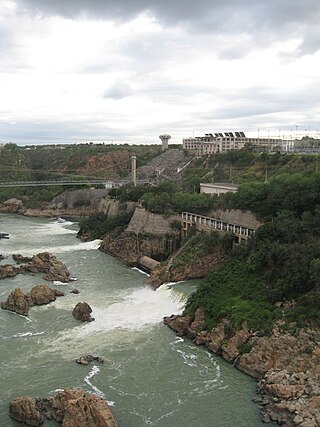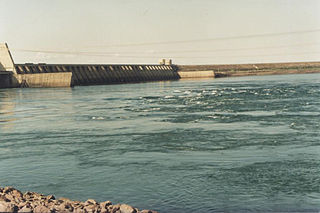
The Itaipu Dam is a hydroelectric dam on the Paraná River located on the border between Brazil and Paraguay. It is the third largest hydroelectric dam in the world, and holds the 45th largest reservoir in the world.

Kárahnjúkar Hydropower Plant, officially called Fljótsdalur Power Station is a hydroelectric power plant in Fljótsdalshérað municipality in eastern Iceland, designed to produce 4,600 gigawatt-hours (17,000 TJ) annually for Alcoa's Fjarðaál aluminum smelter 75 kilometres (47 mi) to the east in Reyðarfjörður. With the installed capacity of 690 megawatts (930,000 hp), the plant is the largest power plant in Iceland. The project, named after the nearby Kárahnjúkar mountains, involves damming the rivers Jökulsá á Dal and Jökulsá í Fljótsdal with five dams, creating three reservoirs. Water from the reservoirs is diverted through 73 kilometres (45 mi) of underground water tunnels and down a 420-metre (1,380 ft) vertical penstock towards a single underground power station. The smelter became fully operational in 2008 and the hydropower project was completed in 2009.

The Robert-Bourassa generating station, formerly known as La Grande-2 (LG-2), is a hydroelectric power station on the La Grande River that is part of Hydro-Québec's James Bay Project in Canada. The station can generate 5,616 MW and its 16 units were gradually commissioned between 1979 and 1981. Annual generation is in the vicinity of 26500 GWh.

Falcon Dam is an earthen embankment dam on the Rio Grande between Starr County in the U.S. state of Texas and the city of Nueva Ciudad Guerrero in the Mexican state of Tamaulipas. The dam was built for water conservation, irrigation, hydroelectric power generation, flood control, and recreational purposes and as an international border crossing between Zapata and Starr Counties and Tamaulipas. Construction on the dam began in December 1950 and ended in April 1954 but it was dedicated by Mexican President Adolfo Ruiz Cortines and U.S. President Dwight D. Eisenhower in October 1953.

The Campos Novos Dam is a hydroelectric dam in the Santa Catarina state in southern Brazil. In 2006, at 200 metres (660 ft) dam height, it was regarded as the third highest dam of this type in the world, but, in June 2006, the water which it held back ran out following a break in the dam wall.

The Xingó Dam is a concrete face rock-fill dam on the São Francisco River on the border of Alagoas and Sergipe, near Piranhas, Brazil. The dam was built for navigation, water supply and hydroelectric power generation as it supports a 3,162 megawatts (4,240,000 hp) power station. It was constructed between 1987 and 1994 and the last of its generators was commissioned in 1997. In Portuguese, the dam is called the Usina Hidrelétrica de Xingó.

The Paulo Afonso Hydroelectric Complex, also known as the Paulo Afonso Complex, is a system of three dams and five hydroelectric power plants on the São Francisco River near the city of Paulo Afonso in Bahia, Brazil. The complex exploits an 80-metre (260 ft) natural gap on the river, known as the Paulo Afonso Falls. Constructed in succession between 1948 and 1979, the dams support the Paulo Afonso I, II, III, IV and Apollonius Sales (Moxotó) power plants which contain a total of 23 generators with an installed capacity of 4,279.6 megawatts (5,739,000 hp).

The Governor Ney Braga de Barros Hydroelectric Plant, formerly known as Segredo, is a dam and hydroelectric power plant on the Iguazu River near Segredo in Paraná, Brazil. It is the fourth dam upstream of the Iguazu Falls and was constructed between 1987 and 1991 while being inaugurated in 1992. The power station has a 1,260 megawatts (1,690,000 hp) capacity and is supplied with water by a concrete face rock-fill embankment dam.
The Governor Bento Munhoz da Rocha Netto Hydroelectric Plant, formerly known as Foz do Areia, is dam and hydroelectric power plant on the Iguazu River near Foz do Areia in Paraná, Brazil. It is the furthest dam upstream of the Iguazu Falls and was constructed between 1976 and 1980. The power station has a 1,676 megawatts (2,248,000 hp) capacity and is supplied with water by a concrete face rock-fill embankment dam.

The Itá Hydroelectric Power Plant is a dam and hydroelectric power plant on the Uruguay River near Itá on the border of Santa Catarina and Rio Grande do Sul, Brazil. The power station has a 1,450-megawatt (1,940,000 hp) capacity and is supplied with water by a concrete face rock-fill embankment dam. It is owned and operated by Tractebel Energia and produces the equivalent of 60% of the energy consumed in Santa Catarina.
The Machadinho Hydroelectric Power Plant is a dam and hydroelectric power plant on the Pelotas River near Machadinho on the border of Santa Catarina and Rio Grande do Sul, Brazil. The power station has a 1,140 MW (1,530,000 hp) capacity and is supplied with water by a concrete face rock-fill embankment dam. It is owned and operated by Machadinho Energetica and produces the equivalent of 37% of the energy consumed in Santa Catarina.

The Engineer Sérgio Motta Dam, formerly known as the Porto Primavera Dam, is an embankment dam on the Paraná River near Rosana in São Paulo, Brazil. It was constructed between 1980 and 1999 for hydroelectric power production, flood control and navigation. An estimated 11 million tropical trees were submerged.

The Itumbiara Dam is an embankment dam on the Paranaíba River near Itumbiara in Goiás, Brazil. The dam serves an associated hydroelectric power plant with a 2,082 megawatts (2,792,000 hp) installed capacity. The power plant is the sixth largest in Brazil and has the largest installed capacity of Eletrobrás Furnas' power plants.

The Marimbondo Dam is an embankment dam on the Grande River near Fronteira in Minas Gerais, Brazil. The dam serves an associated hydroelectric power plant with a 1,440 megawatts (1,930,000 hp) installed capacity.
The Luiz Carlos Barreto de Carvalho Dam is an embankment dam on the Grande River near Fronteira in São Paulo, Brazil. The dam serves an associated hydroelectric power plant with a 1,050 megawatts (1,410,000 hp) installed capacity.

The Engineer Souza Dias Dam, formerly known as the Jupiá Dam, is an embankment dam on the Paraná River near Três Lagoas in Mato Grosso do Sul, Brazil. It was constructed for hydroelectric power production, flood control and navigation. Studies on the dam and power plant began in 1951 which recommended the dam along with the Ilha Solteira Dam. The dam was inaugurated in 1968 and its generators were commissioned between 1969 and 1974.

The Água Vermelha Dam is an embankment dam on the Grande River near Iturama in Minas Gerais/São Paulo, Brazil. It was constructed for hydroelectric power production and flood control. Construction on the dam began in 1973 and it was completed and operational by 1978. The last generators were operational in 1979.
The São Simão Dam is an embankment dam on the Paranaíba River near São Simão in Goiás/Minas Gerais, Brazil. It was constructed for hydroelectric power production and flood control. The dam was completed in 1978 and all generators were operational by 1979. In 1977, the first use of roller compacted concrete in Brazilian dam construction occurred on the São Simão.

Peixoto Dam, also known as Mascarenhas de Moraes Hydroelectric Plant, is a hydroelectric dam on the Grande River in the state of Minas Gerais, Brazil, about 20 kilometres (12 mi) west of Delfinópolis.
The Dona Francisca Hydroelectric Plant is a hydroelectric plant on the Jacuí River in the state of Rio Grande do Sul, Brazil, completed in 2001. It delivers 80 MW guaranteed power.















